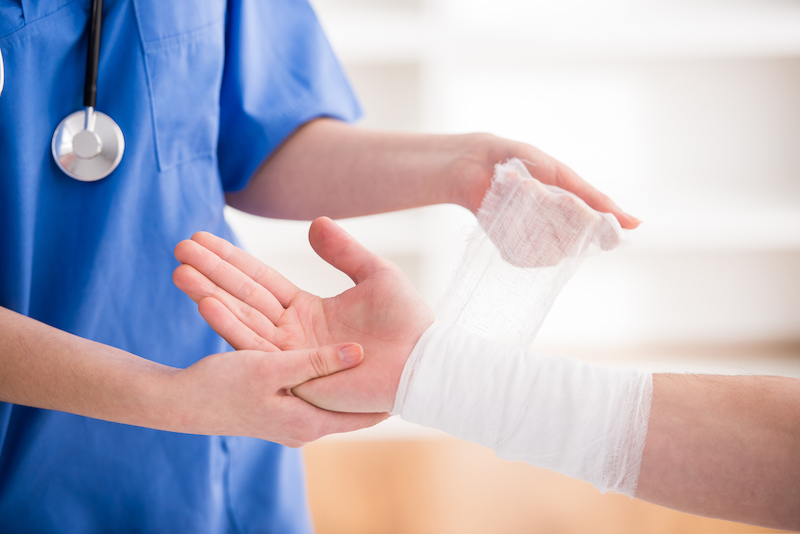Wound Care in Oxnard

Skin is the largest and most visible organ of the body, comprising up to 15-20% of the total body weight. It receives approximately one third of the body’s blood supply at a rate of 300 mls/minute.
Normal skin is composed of two layers: epidermis and dermis. Under the dermis lies the subcutaneous tissue (or hypodermis), a layer of loose connective tissue.
Physiology of Wound Healing
There are four phases of normal wound healing. They are:
1. Hemostasis
2. Inflammatory Phase
3. Proliferative Phase (comprised of granulation and epithelialization)
4. Maturation Phase (also called reconstruction or remodeling phase)
Hemostasis
Hemostasis begins immediately upon wounding. The body’s natural defenses try to control bleeding first by constricting the local blood vessels, and then by creating a plug with circulating platelets. This temporary plug is later replaced by a more durable fibrin clot. This process is quick, occurring over several hours.
Inflammatory Phase
Inflammation is commonly referred to as the clean-up period. White blood cells (neutrophils and macrophages) invade the wound. Dead tissue, debris, and bacteria are first digested by these cells. Growth factors and other chemical messengers are then released. This starts the healing process.
Proliferative Phase
The process of “new” tissue growth or proliferation is subdivided into two phases depending upon the depth of injury: Granulation and Epithelialization.
- Granulation
- All partial and full thickness wounds heal by the process of granulation. The epidermal layer has been destroyed so the natural healing process originates from dermal cells (Fibroblasts) in the wound bed and periwound margins. A new layer of protein (Collagen) is deposited in the wound space. Because of the extent of the damage new blood vessel growth (angiogenesis – Endothelial cells) is required to bring the needed nutrients for healing to the area. Granulation will usually begin within 12 – 48 hours after the initial injury when hemostasis is complete and the inflammatory phase has subsided. This process can be very long, occurring over several months for full thickness wounds. However, only a minimal amount of granulation or the growth of scar tissue is required to fill a partial thickness wound, thus the granulation phase will be much shorter. Granulation, also called scar tissue, is relatively a vascular and is thus different in texture, appearance, and functions of normal skin.
As the wound fills in with new tissue, the edges contract with the aid of specialized cells (Mylofibroblasts), after which epithelialization will commence to resurface the wound.
- Epithelialization
- Superficial wounds heal by Epithelial Regeneration. The natural process of epidermal cell keratinocytes growth and differentiation will result in the resurfacing of the wound with natural skin. The growth originates from keratinocytes in the wound bed, periwound margins, and from islets of epidermal cells (e.g. hair follicles, sweat glands) that remain scattered in the wound tissue. Regeneration will usually begin within 12 – 24 hours after the initial injury, when hemostasis is complete and the inflammatory phase has subsided. Because the damage is not too extensive the wound will regain near normal appearance and strength. The process is usually complete in 3 – 4 weeks.
Maturation Phase
The maturation phase, also known as reconstruction or remodeling, may take up to two years to complete. Newly formed scar tissue realigns its internal structure to increase its durability. The collagen deposits bundle up to increase the tensile strength of the wound. New tissue is quite fragile at this point in time and can be reinjured easily. The healed wound will only regain up to 80% of its original strength.
Types of Wound Healing
Primary
In primary closure, such as with a surgical incision, wound edges are pulled together and approximated with sutures, staples, or adhesive tapes, and healing occurs mainly by connective tissue deposition. Epithelial migration is shortlived and may be completed within 72 hours. Within 24 – 48 hours, epithelial cells migrate from the wound edges in a linear movement along the cut margins of the dermis.
Secondary
In wounds that heal by secondary intention, wound edges are not approximated, and healing occurs by granulation tissue formation and contraction of the wound edges.
Tertiary
Wounds healing by tertiary intention (delayed primary intention). The wound is kept open for several days and the superficial wound edges are then approximated, and the center of the wound heals by granulation tissue formation.
Types of Wound
DIABETIC ULCER
- Wagner Scale
0-Intact Skin
1-Superficial ulcer
2-Deep ulcer
3-Deep infected ulcer
4-Partial foot gangrene
5-Full foot gangrene
PRESSURE ULCERS
- Defined as a localized injury to the skin and/or underlying tissue, usually over a bony prominence
- Mostly preventable
- Risk factors
- Elderly, immobile, incontinent
- Poor perfusion
- Poor nutritional status
- Meds: steroids, anti-neoplastics, chemotherapy, radiation therapy, anti-inflammatories, anticoagulant
VENOUS STASIS ULCERS
- Results from inadequate circulation to the skin and subcutaneous tissue
- May be painful or painless
- Irregular shape, shallow, superficial
- Usually in the lower leg/ankles
- Edema and pigmentation changes
- In patients over 65, 82% of ulcers were secondary to venous insufficiency
- Risk factors include DVT, CHF, Varicose veins, Incompetent valves, malnutrition, etc.
ARTERIAL ULCERS
- Caused by inadequate O2 perfusion-PAD, advanced atherosclerosis, DM, old age, high cholesterol
- Full thickness wounds
- Have a “punched out” appearance with smooth edges
- Wound bed is pale and dry with cool surrounding tissue and pale peri-wound skin
- Can develop into gangrene
- Pain is out of proportion to the size of the wound
OTHER WOUNDS
- Burns-1st, 2nd and 3rd degree
- Gun shot/Traumatic wounds
- Failed skin grafts
- Wound dehiscence
- Infected skin biopsies
- Lymphedema
